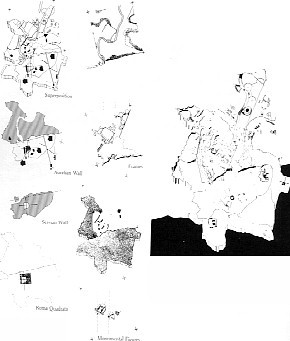| |
74

3. Diagrams showing chronology and framing of the Campo Marzio
4. Axonometric superposition of borders and frames
| |
2013.12.27
750 BC Ara Martis
750 BC Equiria
1150 years
400 Sep. Mariae Honorij Congiig

Position of the Altar of Mars, the Equirra, and the Sepulcher of Maria, wife of Honorius.
The name campus Martius was derived from an ancient altar of Mars, ascribed by tradition to Romulus...
According to Festus, it was Romulus who instituted the first horse-races in honor of Mars. These races became an annual event, and, due to their origin, are rightly considered the "proto" festival or feast of Roman tradition. According to Varro, the races took on the name of Equiria, which is derived "from the equorum cursus 'running of horses'; for on that day they currunt 'run' races in the sports on the Campus Martius." Furthermore, Ovid's Fasti lists the dates of the races as the 27th of February and the 14th of March, and, since the Roman calendar began the 1st of March, the holding of the first horse-race the day just before the new year further attests the Equirria's premire "fest" position.
The sarcophagus of Maria may well be the last substantial imperial artifact of (the city of) Rome, and, after an illustrious title page and a frontispiece, it is an image of the sarcophagus of Maria that Piranesi uses to begin his Campo Marzio publication. In a most elegantly covert way, Piranesi began the 'history' of the Campo Marzio with what is really it's ending, and what is probably the world's greatest designed architectural inversionary double theater goes on from there.
|